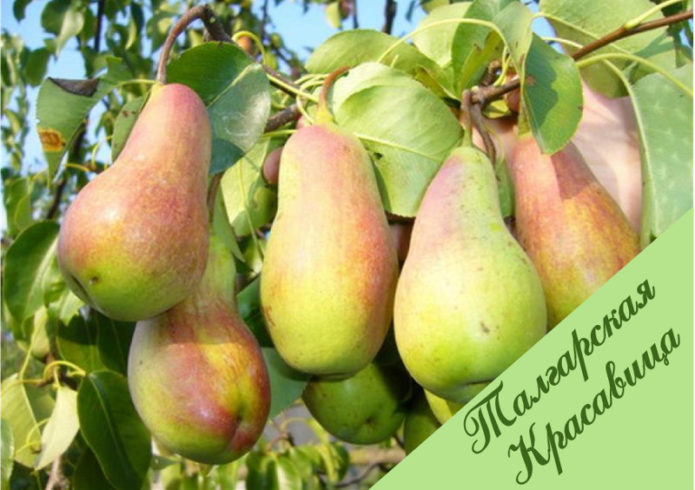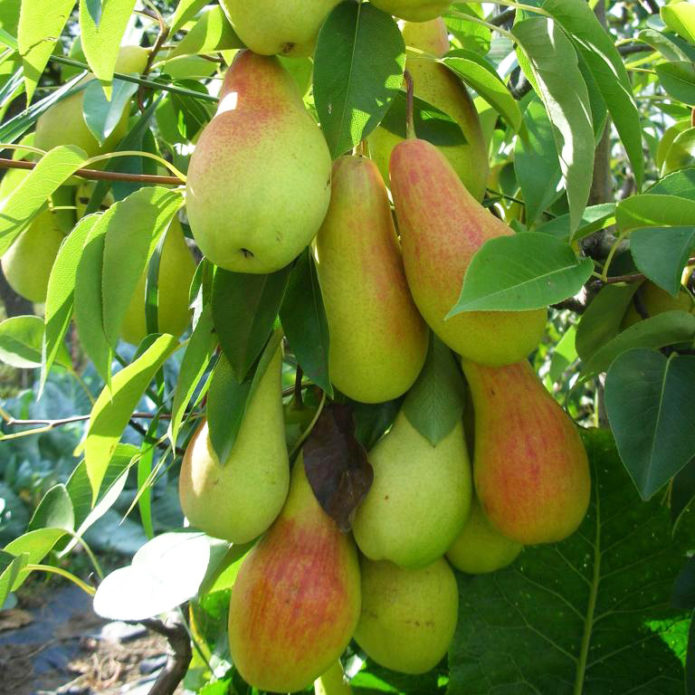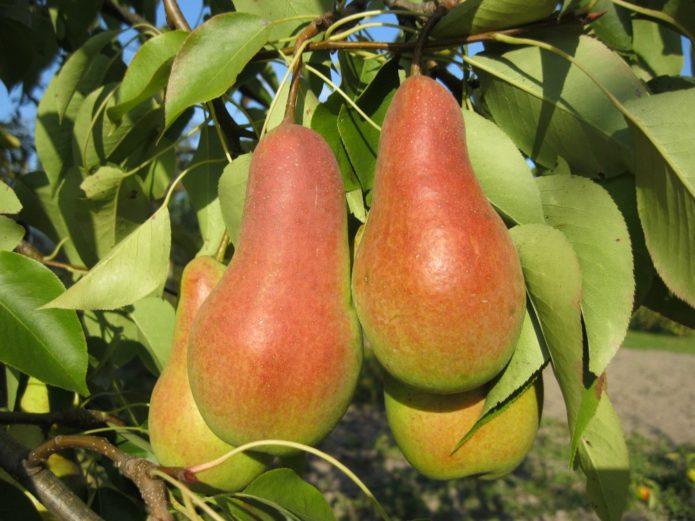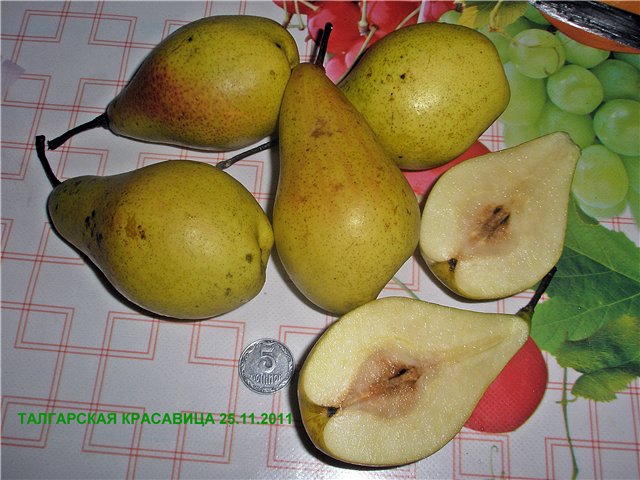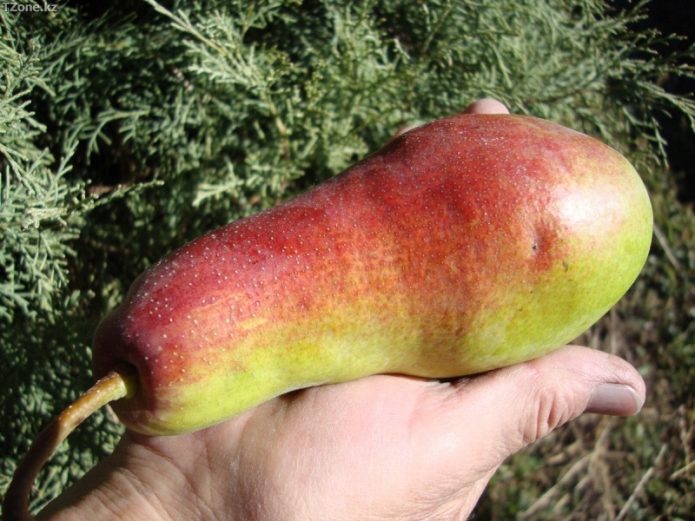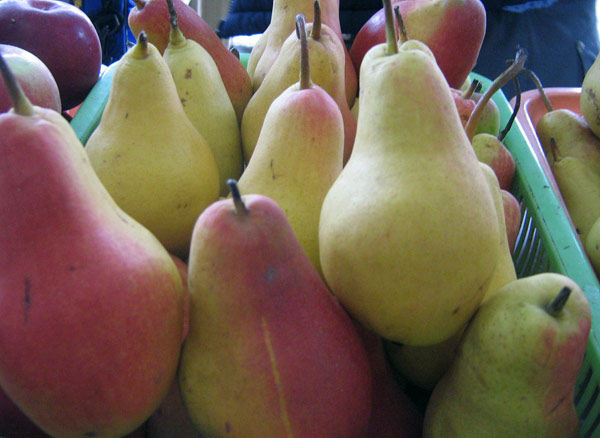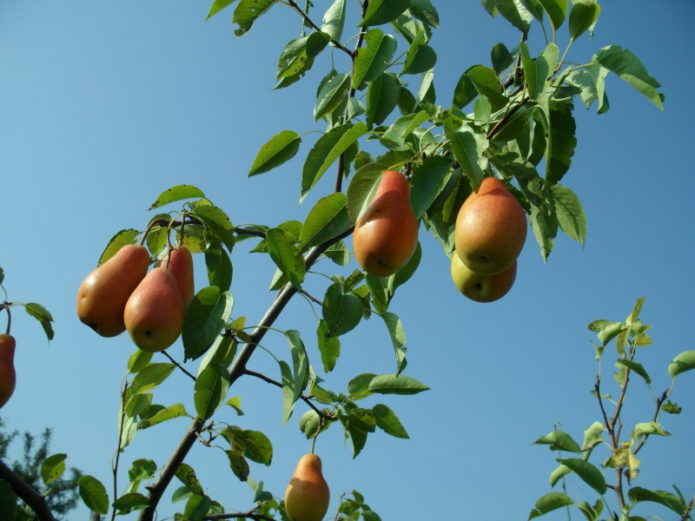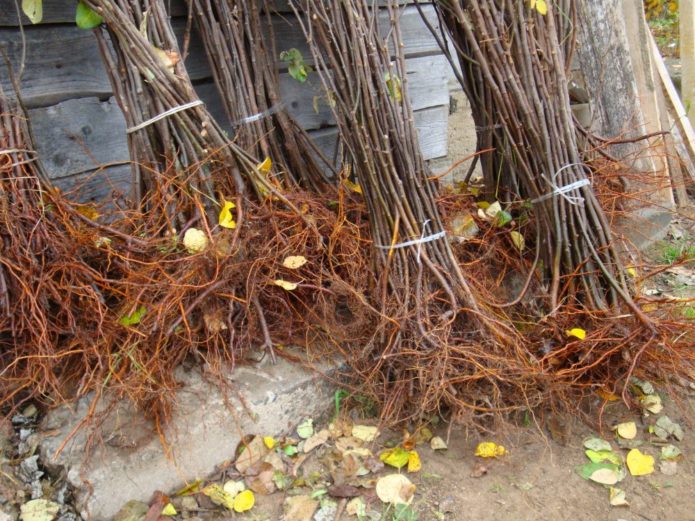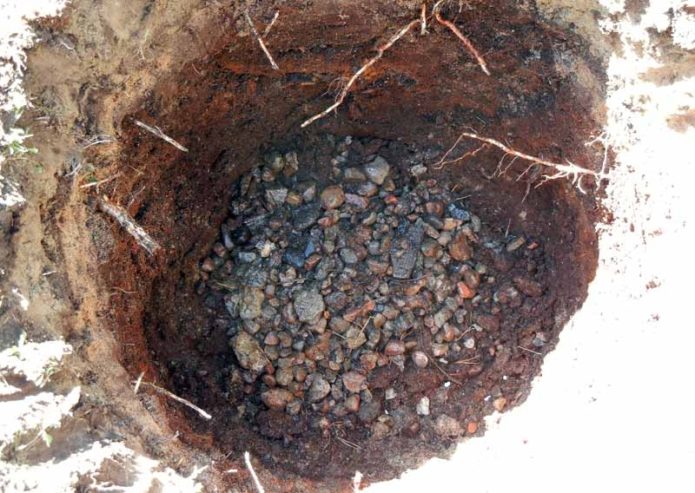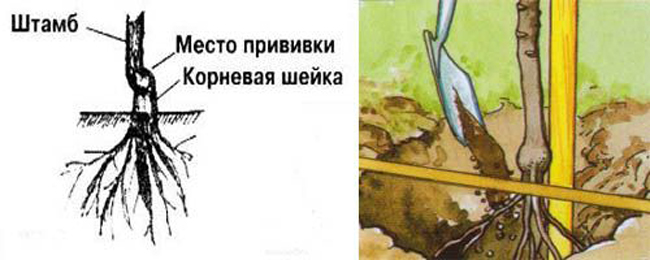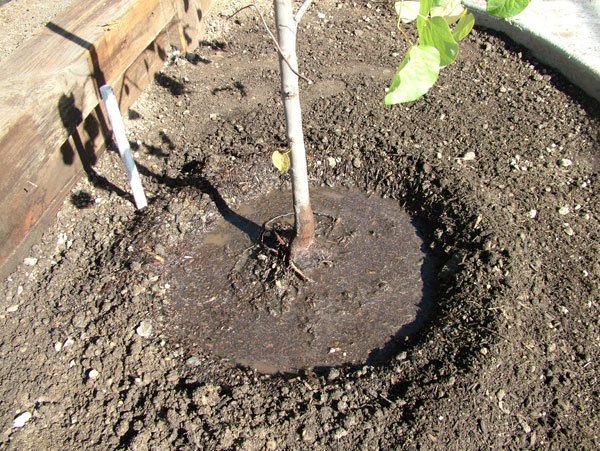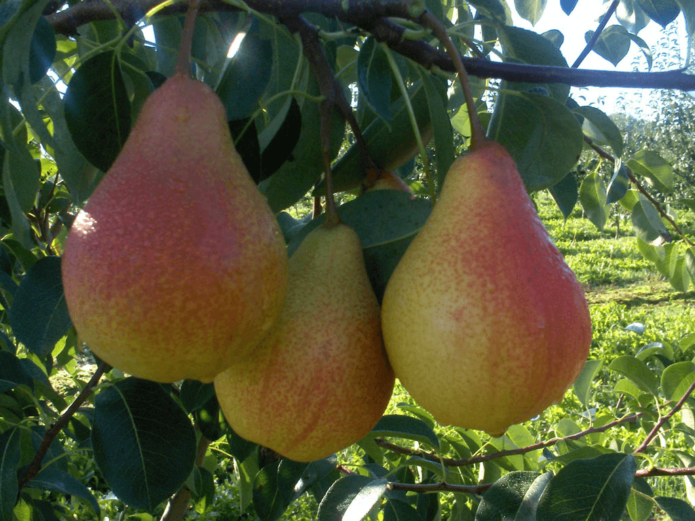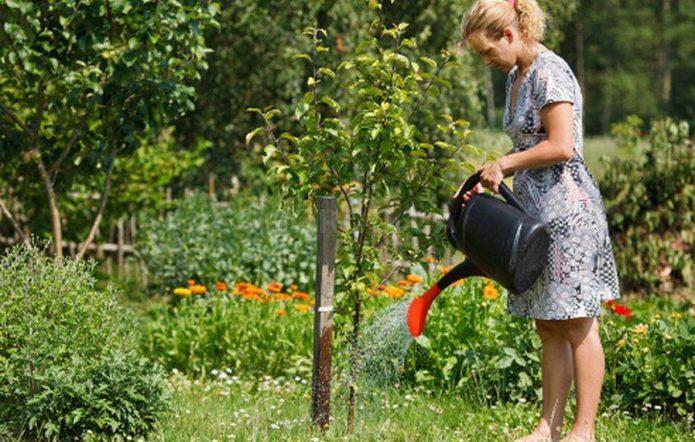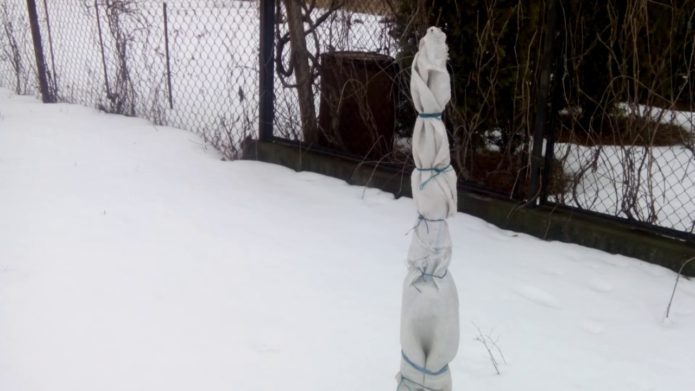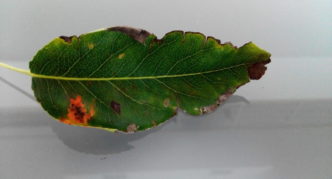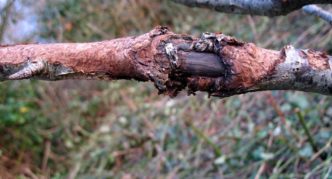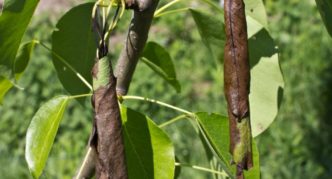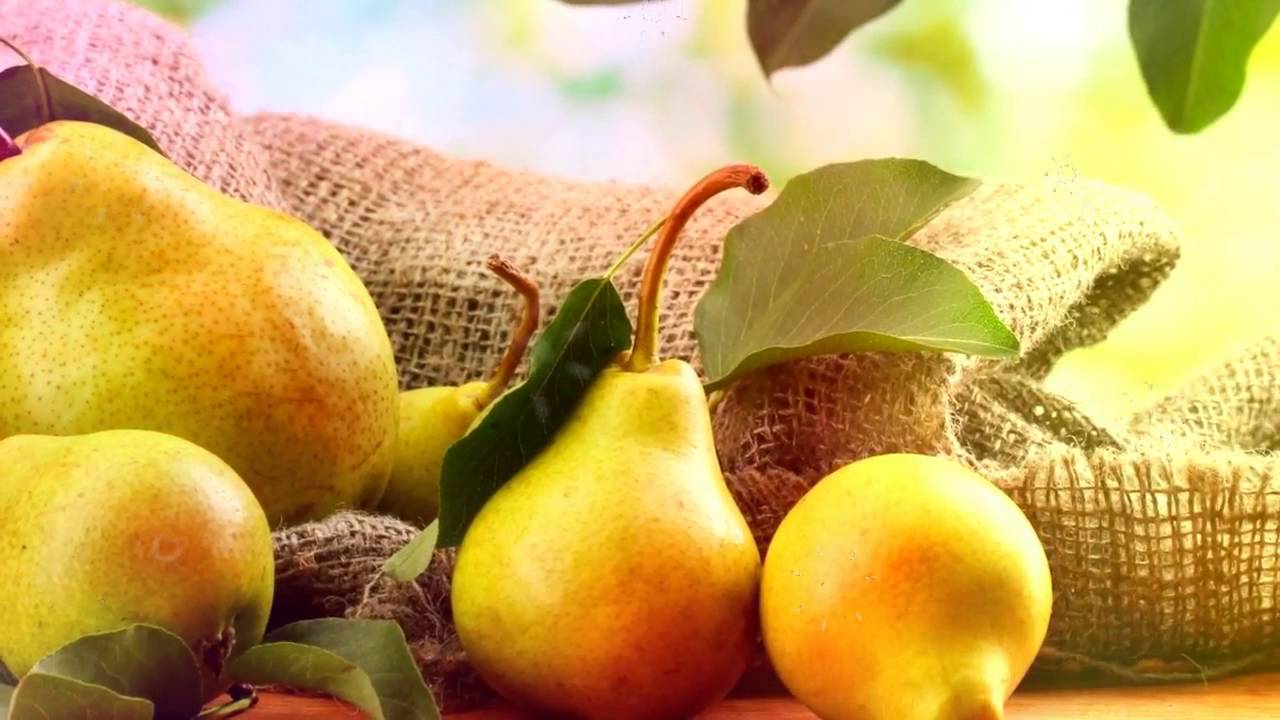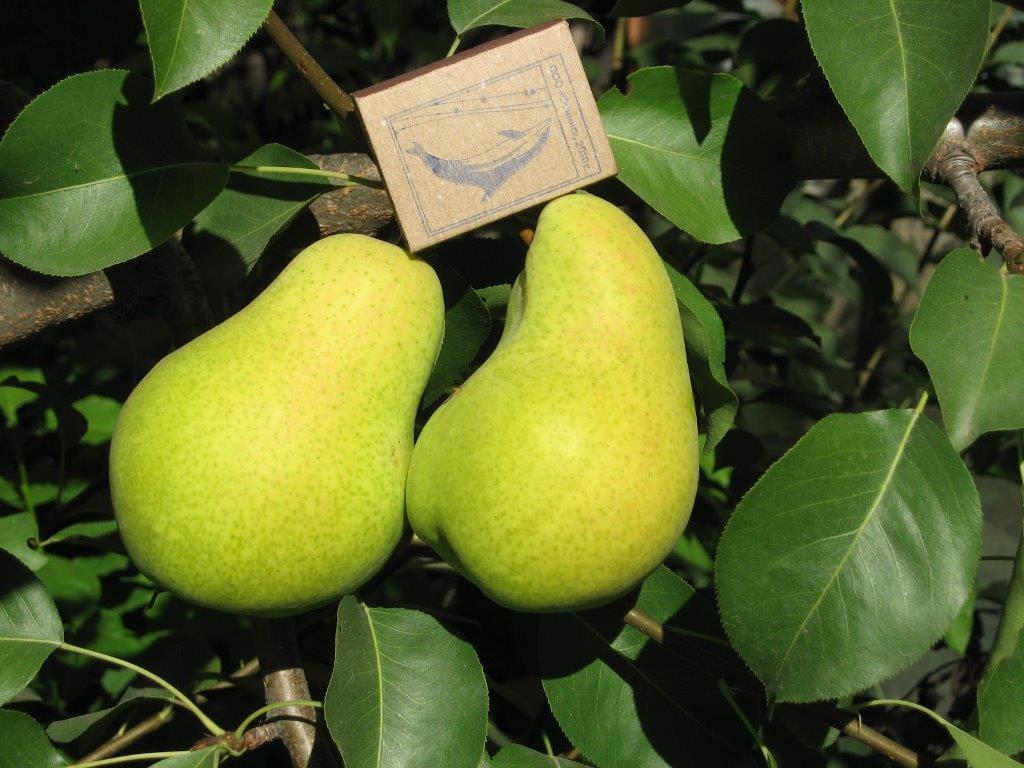Choosing a pear for his site, the gardener certainly wants to plant a variety that will yield tasty fruits in sufficient quantities with minimal care. There are such varieties, and there are many of them. Among them I would like to mention the Talgar beauty, bred in one of the union republics of the USSR. The excellent characteristic is confirmed by the popularity of the variety, which has been grown for many years.
Content
The history of the origin of the variety Talgar beauty
A pear with such a beautiful name has more than half a century of history. It began in sunny Kazakhstan. Or rather, at the Kazakh Research Institute of Fruit and Viticulture. There, from the old Belgian variety Forest Beauty, through free pollination, it was possible to get a new pear with fruits of an unusual shape. The novelty was named Talgar beauty.
By the way, the name Talgar is very common in Kazakhstan. It is worn by the city and the river. There is also Talgar peak and the famous Talgar gorge, through which tourist routes pass.
Variety trials began in 1960, and since 1991 the Talgar beauty has been zoned for the North Caucasian region. The most favorable areas that allow you to unleash the full potential of the beauty pear are:
- Dagestan;
- Chechnya;
- Ingushetia;
- North Ossetia;
- Stavropol region;
- Kabardino-Balkaria;
- Adygea;
- Krasnodar region;
- Rostov region;
- Crimea;
- Ukraine.
Appearance and characteristics of the variety
The tree of the Talgar beauty is relatively small. The height of the tree is about 3 m. The not too dense crown resembles a pyramid with a wide base, which is formed by hanging branches. The main difference of the variety is that the skeletal branches forming the crown extend perpendicularly from the trunk, that is, at an angle close to right. Such an attachment is considered the most correct, since the acute angle of attachment of the branch leads to a weak connection between it and the trunk. The bark covering the trunk and skeletal branches is gray and slightly flaky. Shoots of medium thickness grow straight, the bark on them is brown, without pubescence. Lentils are clearly visible on young branches. The bulk of the crop is tied on ringlets.
The buds are large, conical in shape, without pubescence, appressed. The leaf plate is large, dark green. The slight concavity makes it look like a boat. Leaf shape is ovoid, long-pointed. The surface is smooth, shiny, with slight veins. The edge of the leaf is covered with small notches. Petioles are long.The Talgar beauty blooms around mid-May, so the flowers do not suffer from recurrent frosts.
The fruits have a very unusual shape - elongated pear-shaped, or, in other words, bottle-shaped. The fruit tip is slightly truncated. Weighty pears - from 140 to 200 g. If we take the average, then it comes out about 170 g. Single specimens can weigh up to 250 g. The skin covering the fruit is not thick, noticeably oily to the touch and shines glossy in the sun. The main color is pale yellow. On the sunny side, a beautiful red carmine bright blush appears. There are many subcutaneous points. On the uncolored part of the fruit, they are green, on the illuminated part - white, clearly visible. The funnel is very shallow; many fruits are completely absent. The seed chambers are small, closed. The peduncle is medium, curved.
The pears of the Talgar beauty have a very attractive appearance, since their surface is not damaged by rustiness, which, to a greater or lesser extent, is found on the fruits of many varieties.
The pulp is of a pleasant creamy color, medium density, juicy, fine-grained in structure, crunchy. The taste is very good, sweet. The aroma is delicate. Assessment of tasters - 4.0 - 5.0 points. Such a wide variation in taste assessment is due to the consistency, not everyone likes crispy pear pulp. But it is this crunch that speaks of the presence of stony cells, the shell of which consists of lignified fiber.
If the Talgar beauty is grown in the southern regions, for example, in the Kuban, its pulp contains more sugars.
The content of substances in the fruit - table
| Substances | Content |
| Sahara | 9,0% |
| Titratable acids | 0,37% |
| Vitamin C | 7 mg / 100 g |
| Dry matter | 15% |
| P-active catechins | 54.0 mg / 100 g |
Characteristic
The characteristic of the Talgar beauty variety is proof of its popularity.
- The fruiting period for the Talgar beauty begins quite quickly - for 4 - 5 years. Although the first fruits in small quantities are able to set on a 2 or 3-year-old tree.
- The pear is an autumn variety that allows you to prolong your intake of live vitamins after the summer season is over. Fruits begin to ripen at the end of September, consumer ripeness occurs in October-November.
- The variety bears fruit annually, and the yield only increases from year to year. 30 - 35 kg of fruit can be removed from one tree. From a centner, these figures are 150 - 200 kg.
- Even with gusts of wind, ripe fruits do not crumble. The dense consistency of the pulp protects from damage when pressed.
- Shelf life is up to 3 months. The fruits can withstand transportation.
- Talgar beauty has good drought resistance.
- The indicators of winter hardiness are quite high. An adult pear can withstand frosts of 30 degrees. Even if the wood freezes, the tree can quickly recover.
- The variety shows good resistance to various fungal diseases, such as scab. Pests are not afraid of her either.
Advantages and disadvantages - table
| Advantages | disadvantages |
| Excellent fruit appearance | When picked late, the flesh may turn brown |
| Stable fruiting | Pollinators Wanted |
| The yield is very good | |
| Disease and pest resistance | |
| Long shelf life and possibility long distance transportation | |
| Winter hardiness and drought resistance on high level |
The fruits of the Talgar beauty under normal conditions can retain their presentation for a long time. But for this, pears are removed from the branch a little earlier than the due date. If the fruit is overripe, the flesh becomes brownish and the storage time is reduced.
Planting pears Talgar beauty
Study the soil before choosing a planting site. In relation to soils, a pear-beauty can be capricious. She prefers an area with fertile loose soil of neutral acidity. The pear will not grow well on sandy, clayey and waterlogged soils.
In areas where subsoil water flows above 2 m to the surface, an artificial hill 50 - 70 cm high must be built for planting.
The Talgar beauty is very fond of the sun. Therefore, choose a place on the south or southwest side of the site, where the lighting will be most intense. An adult tree is not afraid of the wind, but at first it is better to protect the seedling from the prevailing wind.
In places where the pear is zoned, autumn planting is preferred, which frees the gardener from frequent watering after planting. But the Talgar beauty can be successfully grown in the Moscow region. In this region, the seedling can also be planted in spring. Before the onset of the summer heat, the tree will have time to take root, and by winter it will finally get stronger.
Often we are in a hurry, digging the planting hole just before planting. This cannot be done. Regardless of the timing, prepare the pit in advance. In order for the soil to be structured and nutrients are evenly distributed in it, ideally, it should take up to six months. The minimum period from preparation to planting a seedling is at least 3 weeks.

The planting of the Talgar beauty is usually carried out in the fall, but in cool regions this work is best done in the spring.
Now about the seedlings, because the final result depends on the correct choice of planting material.
- give preference to young trees. One-year-old or 2-year-old seedlings have the highest survival rate;
- of course, you also need to pay attention to the root system. It should have up to 3 main root processes covered with a mesh of suction roots. Broken areas or signs of disease are unacceptable;
- the trunk should be flat, with smooth and elastic bark. The wrinkles on the trunk are evidence that the plant was dug up long ago and it may have begun to dry out.
Scion features
When choosing a seedling, pay attention to the grafting.
- most often the rootstock for the variety is quince, due to its excellent compatibility;
- on a low-growing rootstock, the pear grows more compact and quickly enters the fruiting period;
- if the variety is grafted onto the Ussuri pear, the winter hardiness of the Talgar beauty will increase.
Basic landing rules
- The pit should be sized to easily accommodate the root system. As a rule, for pear seedlings, it is enough to dig a hole with a depth of at least 60 cm, with a diameter of 80 to 1 m.
- Carefully set aside the removed topsoil. Add 2 - 3 buckets of any organic matter to it (manure must be rotted), phosphorus and potash fertilizers. Mix the nutrients well with the ground.
- If the soil is clayey in your area, moisture can accumulate in the pit, which will lead to the death of the root system. To avoid this, deepen the hole to 80 cm, and lay a drainage layer (gravel or broken brick) on the bottom. Only then add the nutrient mixture.
- If the roots of the seedling are dry, they are immersed in water for several hours. Immediately before planting, the root system can be dipped in a clay mash.
- The root collar (the place where the root merges into the trunk) should not be buried or too high above the ground. When properly planted, its height above the planting level should be on average 4 cm.
- If, after watering, the soil has subsided greatly and the roots are bare, they need to be sprinkled with soil.
Are pollinators needed
Talgar beauty is a self-fertile variety. This is perhaps the only significant drawback. But it is easy to fix it by planting nearby varieties suitable for pollination. Favorite Klapp, Hoverla or Conference will help to tie a large and high-quality harvest.
Features of growing and care
Talgar beauty is unpretentious in terms of care. She perfectly adapts to climatic conditions. But in order for a fully fruiting tree to grow from a seedling, you need to make a little effort.
Watering and feeding
The characteristic indicates the drought resistance of the variety. But this applies to extreme situations that have developed not through the fault of the gardener, but solely due to weather conditions. Watering the Talgar beauty is a must. Spring planting seedlings are especially sensitive to water shortage. In order for the root system to develop normally, young trees must be watered in the spring and in the first half of summer once a week, 1 bucket for a seedling. In the second half of summer, the frequency of watering is reduced, and in September they practically stop, so as not to cause a prolonged growth of shoots.
An adult pear is watered 3-4 times during the growing season. This is not the final figure. The amount of moisture can both increase and decrease depending on the abundance or absence of precipitation. You also need to take into account the characteristics of the soil on the site. But you need to know the main stages of watering. The pear needs to be watered:
- during flowering or immediately after its end;
- when the fruits start to pour. In the same period, the next year's harvest is laid.
A mature tree needs more moisture. Therefore, we break watering into morning and evening watering, pouring 1 - 2 buckets of water under the tree at a time. If the autumn is dry, water charging is carried out, which is characterized by abundance - up to 60 liters of water under one pear. Sprinkler irrigation is considered the best watering method. In the absence of such a humidification system, they use a long-proven method - they dig out annular grooves around the perimeter of the crown, where water is poured.
In order to keep moisture in the soil as long as possible, the trunk circle is covered with mulch after watering. It is also a good way to control weeds.
The first year after planting, provided that nutrients have been introduced into the planting pit, it is not required to fertilize the seedling. Then fertilizing is applied annually, trying to alternate mineral fertilizers with organic matter. By the way, do not forget about wood ash, which contains the elements necessary for a pear.
- in the spring, nitrogen-containing fertilizers are mainly used;
- in the summer, phosphorus-potassium dressings will be beneficial.
By the way, before entering the fruiting period, nitrogen is the main fertilizer for the Talgar beauty. It is this substance that helps to quickly grow the crown. But too much of it will not be beneficial. You must strictly adhere to the standards indicated on the package.
The method of fertilizing is also traditional - substances dissolved in water are introduced into the moistened soil. If the weather is rainy, then you can scatter mineral or organic fertilizing in the pear tree trunk circle.

In wet weather, you can not bother with the preparation of the solution, but apply fertilizers directly under the tree, mixing them well with the ground
Pruning
After the end of the formation of the crown of the pear, the gardener must carry out 2 types of annual pruning:
- thinning - it frees the crown from excessive thickening, helps to correctly distribute the fruit load and contributes to an even distribution of sunlight;
- sanitary - remove dry, diseased and broken branches.
When the growth process is attenuated in an adult pear and the yield decreases, rejuvenating pruning is carried out, which allows you to give a new impetus to the development of the tree.
Preparing for the winter period
The seedling must be insulated for the winter. Wrap up the trunk, skeletal twigs and cover the root area with a 15 cm layer of mulch. MThe material for insulating the trunk must be air-tight. Otherwise, the crust may undercut and flake off. If manure is used as mulch, it should not come into contact with the trunk.
An adult Talgar beauty is prepared a little differently for the winter period. If necessary, carry out sanitary pruning, be sure to clean and whitewash the trunk. It is not necessary to wrap it up, unless a very frosty and snowless winter is expected with strong winds that can dry out the wood. The root zone must be insulated with mulching materials.

To protect the stem of an adult pear from possible temperature extremes, it is covered with a lime solution
Diseases and pests of the Talgar beauty
Gardeners note the high resistance of pears to fungal diseases, for example, to scab, which is the scourge of stone fruits, especially in a cool and humid period. But periodically, certain diseases may occur, the spread of which happens either due to the carelessness of the gardener, or due to bad weather conditions. The same thing happens with pests. Weeds removed at the wrong time or crown thickening are all prerequisites for the invasion of harmful insects. Therefore, the task of the gardener is not only to properly carry out the care, but also to be able to recognize the symptoms in time in order to avoid big problems.
Diseases and pests - table
| Diseases and pests | Symptoms | Control measures | Prevention |
| Rust | Most often, the disease affects leaves. They appear rusty stains. Affected leaves dry up and fall off. | Treat with 1% solution Bordeaux liquid twice:
Instead of Bordeaux liquid |
foliage and burn it.
carry out simultaneous processing |
| Cytosporosis | First of all suffer old unkempt pears. The disease is evidenced areas with drying bark, having red-brown color. If the disease touches branches - they dry up. Launched cytosporosis can completely destroy the tree. |
Nitrofen solution or
liquid after flowering with |
cut off the affected area to
branches and together with fallen leaves |
| Pear moth | Moth larva gnaws through the passages in the fruit so that get to the seed box. As a result, the fruits become unsuitable for storage. | Process after flowering Agravertine solution - 5 ml 10 liters of water. |
trunk hunting belts.
trunk circle and destroy |
| Pear tube wrench | Lays eggs in rolled straw leaves, after which those wither and dry up. | Immediately after flowering, spend treatment with one of the drugs:
|
burn.
a circle. |
Diseases and pests of the Talgar beauty - photo gallery
- After the appearance of rusty stains, the leaf begins to dry out
- The branch damaged by cytosporosis dies
- The pear leafworm larva spoils the fruit
- The leaves affected by the pipe-runner dry up
Reviews about the variety Talgar beauty
They treated me to a Talgar beauty, tasted it. To the touch it is hard, like butter, rubbed peel, exuding an unusual aroma. Like a store Forest Beauty. Crispy, very juicy pulp, but not stone. Harmonious sweet and sour taste, the juice sprinkles when biting off. The only thing that is absent is oiliness. pulp. It looks like parthenocarpic, there are almost no seeds. The variety is considered autumn, but there is information about excellent preservation in the basement until April.
I also grow Talgar beauty she was 4 years old, they gave her what to do it is necessary to grow the gift, after all, every year the tops freeze, but it grows, restrained growth is visible not for our area, she does not like our frosts, and the frosts were super
The best pear for me is the Talgar beauty. It lies well in the refrigerator. The pear is, in principle, beneficial, it grows a tree and grows for many years. If apple trees can have periodic fruiting, then there is always a pear, even if there are recurrent frosts….
After the first fruiting, I also decided to re-graft, and even did it on 2 branches - it worked. And she was frightened and last autumn - the second harvest, I really liked it. There was an incomplete bucket, we kept it in the refrigerator until the beginning of November, we ate everything. Taste, I realized, depends on the weather and feeding, it must be removed on time, not overexposed. I didn't like the skin - it's tough, but you can clean it with a knife. But the main plus is problem-free. Further grafting is being postponed.
Talgar beauty is an unpretentious and generous variety. Delicious and juicy fruits will come in handy in the autumn, when the wave of cherries has subsided long ago, and besides apples, there is nothing to pamper yourself with. So, the variety will surprise you not only with delicious fruits. They are very useful. But in preparing the body for the winter period, accumulating more vitamins is perhaps the main task.
